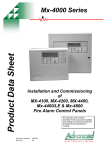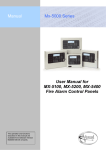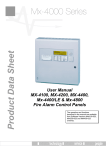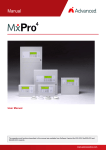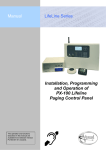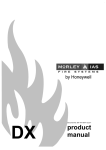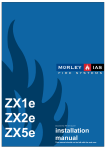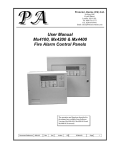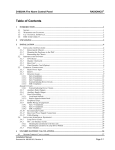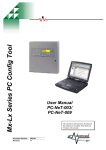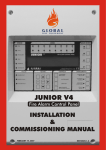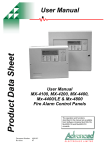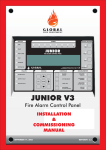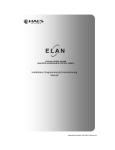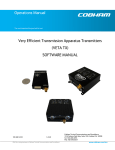Download Mx4000 - Tann Synchronome
Transcript
Technical Data Sheet Installation & Commissioning Manual MX4100, MX4200 & MX4400 Fire Alarm Control Panels The operation and functions described in the manual are available from Software Versions Mx4100-015, Mx4200-015 and Mx4400-015 onwards. Document Reference 680-014 Rev 06 Author PS RFM4100 Page 1 of 53 Specifications Mx-4100 Mx-4200 Mx-4400 Enclosure Steel IP40 Steel IP 40 Steel IP40 Dimensions H x W x D mm 320 x 345 x 85 475 x 450 x 115 475 x 450 x 115 Weight 5Kg 10.5Kg 10.5Kg Temperature 0°C to 45°C 0°to 45°C 0°C to 45°C Cable Entries (20mm knockouts) 7 x top and 7 x top rear 18 x top, 9 x top rear and 2 x bottom 18 x top, 9 x top rear and 2 x bottom 230V 50/60Hz AC (+10%, -15%) 0.4A max 90 –265V, 47 –63 Hz AC, 1.9A @ 90V, 0.64A @ 265V 90 - 265V, 47-63Hz AC, 2.3A @ 90V, 0.95A @ 265V Battery Capacity (For 24Hr. standby) 24V 4Ah Internal (min) 24V 4Ah Internal (minimum) 24V 4Ah Internal (minimum) 24V 7Ah Internal (max) 24V 17Ah Internal (maximum) 24V 17 Ah Internal (maximum) 24V 12Ah External max. 24V 48 Ah External (max) 24V 48Ah External (max) Charging Current 0.4A Temperature Compensated 2A Temperature Compensated 2.2A Temperature Compensated Power Supply On-board 24V DC, 2A High Efficiency Switched Mode Separate 24V DC, 4A Universal Input Switched Mode Number of Fire Zones 100 (250 when networked) 200 (1000 when networked) Separate 24V DC, 5A Universal Input Switched Mode 200 (1000 when Networked) Number of Loops 1 1 to 2 1 to 4 Devices per Loop As per Detector Manufacturer’s Specifications Loop Current * 500mA max. Protocols Apollo: S90, XP95, Discovery, Explorer & Hochiki ESP Sounder Outputs * 2 x 1A Programmable (Total output current from panel not to exceed 2Amps) 2 x 1A Programmable 4 x 1A Programmable Relay Outputs 2 x1A 30VAC/DC (max) 10mA 5V (min) Programmable 2 x 1A 30V AC/DC (max) 10mA. 5V (min) Programmable 2 x 1A 30V AC/DC (max) 10mA. 5V (min) Programmable Open Collector Outputs 2 x Programmable 2 x Programmable 2 x Programmable 10mA 30V DC (max) 10mA 30V DC (max) 10mA 30V DC (max) Digital Outputs --- 6 x Programmable 6 x Programmable Auxiliary Supply Output 24V DC, 300mA 24V DC, 300mA 24V DC, 300mA See notes See notes See notes Event Log 1000 Event & Diagnostic + 500 Fire Mains Supply 500mA max. per Loop 500mA max. per Loop Notes Aux supply tracks a maximum of 0.5V below battery terminal voltage when no mains supply available. Document Reference 680-014 Rev 06 Author PS RFM4100 Page 2 of 53 Standards: The Mx-4100, 4200 and Mx-4400 Fire Alarm Control Panels conform to the following standards: BS EN54-2: 1998 Control and Indicating Equipment BS EN54-4: 1998 Power Supply Equipment BS EN60950: 2000 Safety of information technology equipment BS EN50130-4: 196 Product Family Standard Electromagnetic Compatibility Directive 89/336/EEC (and the amending directive 92/23/EEC) Low Voltage Directive 73/23/EEC Contents 1 Introduction _____________________________________________________ 6 1.1 EN54 Functions ___________________________________________________________7 1.2 Installation Approvals ______________________________________________________7 1.2.1 1.2.2 2 Fire System Installations _________________________________________________________ 7 Wiring Regulations______________________________________________________________ 7 Installation ______________________________________________________ 8 2.1 2.1.1 2.1.2 2.2 2.2.1 2.2.2 2.2.3 2.2.4 2.2.5 2.3 2.3.1 2.3.2 2.3.3 2.3.4 2.3.5 2.3.6 2.3.7 2.4 Identification of Parts ______________________________________________________8 Mx-4100 ______________________________________________________________________ 8 Mx-4200 & Mx-4400 ____________________________________________________________ 8 Installing the Mx-4100 Enclosure_____________________________________________9 Removing and Replacing the Enclosure Cover of the Mx-4100 ___________________________ 9 Removing the Chassis ___________________________________________________________ 9 Mounting the Enclosure __________________________________________________________ 9 Remounting the Chassis _________________________________________________________ 10 Recommended Cable Routing Arrangement _________________________________________ 10 Installing the Mx-4200 & 4400 Enclosures ____________________________________11 Opening the Enclosure Cover_____________________________________________________ 11 Removing the Chassis __________________________________________________________ 11 Mounting the Enclosure _________________________________________________________ 11 Remounting the Chassis _________________________________________________________ 12 Recommended Cable Routing Arrangement _________________________________________ 12 Installing Additional Loop Circuits in the Mx4200 & Mx-4400 __________________________ 13 Removing a Loop Driver Card ____________________________________________________ 13 Wiring Installation _______________________________________________________14 2.4.1 AC Mains Wiring ______________________________________________________________ 14 2.4.1.1 Cable Gland _____________________________________________________________ 14 2.4.2 Battery Installation _____________________________________________________________ 15 2.4.2.1 Mx-4100 ________________________________________________________________ 15 2.4.2.2 Mx-4200 & Mx-4400 ______________________________________________________ 16 2.4.3 Detector Loop Installation _______________________________________________________ 17 2.4.4 Sounder Circuits _______________________________________________________________ 18 2.4.5 Relay Circuits _________________________________________________________________ 18 2.4.6 Open Collector Outputs _________________________________________________________ 19 2.4.7 Auxiliary Supply Output ________________________________________________________ 19 2.4.8 RS232 Interface _______________________________________________________________ 20 Document Reference 680-014 Rev 06 Author PS RFM4100 Page 3 of 53 3 Programming __________________________________________________ 21 3.1 3.1.1 3.1.2 3.1.3 3.1.4 3.1.5 Introduction ____________________________________________________________ 21 Access Levels ________________________________________________________________ Memory Lock ________________________________________________________________ Navigating through menus _______________________________________________________ Changing Text Descriptions______________________________________________________ Numeric data entry_____________________________________________________________ 21 21 21 22 23 3.2 Recommended Programming Procedure_____________________________________ 23 3.3 Level 3 Menu Functions __________________________________________________ 23 3.3.1 Loops _______________________________________________________________________ 3.3.2 Loops - View/Edit _____________________________________________________________ 3.3.2.1 State ___________________________________________________________________ 3.3.2.2 Type ___________________________________________________________________ 3.3.2.3 Value __________________________________________________________________ 3.3.2.4 Zone ___________________________________________________________________ 3.3.2.5 Device Text _____________________________________________________________ 3.3.2.6 Action __________________________________________________________________ 3.3.2.7 Sensitivity_______________________________________________________________ 3.3.2.7.1 Mode- Apollo: _________________________________________________________ 3.3.2.7.2 Mode- Hochiki: ________________________________________________________ 3.3.2.7.3 Delay ________________________________________________________________ 3.3.2.7.4 Alarm- Apollo _________________________________________________________ 3.3.2.7.5 Alarm- Hochiki ________________________________________________________ 3.3.2.7.6 Pre-Alarm ____________________________________________________________ 3.3.2.7.7 Minimum Value________________________________________________________ 3.3.2.7.8 Special Sensitivity Mode SSM/Clock _______________________________________ 3.3.2.8 O/P Group ______________________________________________________________ 3.3.2.9 Additional Info ___________________________________________________________ 3.3.2.10 Detector Testing __________________________________________________________ 3.3.3 Loops - Auto Learn ____________________________________________________________ 3.3.3.1 Normal Procedure / Initial learn ______________________________________________ 3.3.3.2 Procedure if the Panel finds Devices Missing ___________________________________ 3.3.3.3 Procedure if the Panel finds Devices Added ____________________________________ 3.3.3.4 Procedure if the Panel finds Devices Changed___________________________________ 3.3.4 Zones _______________________________________________________________________ 3.3.5 Exit_________________________________________________________________________ 3.3.6 Outputs______________________________________________________________________ 3.3.6.1 Default Output Settings ____________________________________________________ 3.3.6.2 Cause __________________________________________________________________ 3.3.6.3 Style ___________________________________________________________________ 3.3.6.3.1 Delay ________________________________________________________________ 3.3.6.3.2 Mode ________________________________________________________________ 3.3.6.3.3 Wait _________________________________________________________________ 3.3.6.4 Copying Output Settings to Multiple Zones ____________________________________ 3.3.7 Investigation Delays____________________________________________________________ 3.3.7.1 Overriding Delays at Level 1 ________________________________________________ 3.3.8 Time and Date ________________________________________________________________ 3.3.9 View Options _________________________________________________________________ 3.3.10 Passwords _________________________________________________________________ 3.3.11 Panel _____________________________________________________________________ 3.3.12 PC Config _________________________________________________________________ 3.3.13 Setup _____________________________________________________________________ 3.3.13.1 Network ________________________________________________________________ 3.3.13.2 Panel Zone ______________________________________________________________ 3.3.13.3 Service Number __________________________________________________________ 3.3.13.4 Service Due Date _________________________________________________________ 3.3.13.5 Trace Logging Mode ______________________________________________________ 3.3.13.6 Detector Blinking _________________________________________________________ 3.3.13.7 Company LCD Logo ______________________________________________________ Document Reference 680-014 Rev 06 Author PS RFM4100 Page 4 of 53 24 24 24 24 25 25 25 25 26 26 26 27 27 27 27 27 27 28 28 29 29 29 30 30 30 31 31 32 32 33 34 34 34 34 34 35 35 35 36 36 36 37 37 37 37 37 38 38 38 39 3.3.13.8 3.3.13.9 Program ID ______________________________________________________________ 39 Config Data______________________________________________________________ 39 4 EN54 Optional Features __________________________________________ 40 5 Service and Maintenance _________________________________________ 41 5.1 5.1.1 5.1.2 5.1.3 5.1.4 5.2 Maintenance Schedule_____________________________________________________41 Daily Actions _________________________________________________________________ 41 Monthly Actions_______________________________________________________________ 41 Quarterly Actions ______________________________________________________________ 41 Annual Actions________________________________________________________________ 41 Replacement of Components _______________________________________________42 5.2.1 Batteries _____________________________________________________________________ 42 5.2.1.1 Standby Batteries _________________________________________________________ 42 5.2.1.2 Lithium Battery___________________________________________________________ 42 5.2.2 Liquid Crystal Display __________________________________________________________ 43 6 Appendices ____________________________________________________ 44 6.1 Appendix 1 – Forgotten Level 3 Password ____________________________________44 6.2 Appendix 2 – Recommended Cables _________________________________________45 6.3 Appendix 3 – Battery Standby Calculation Chart ______________________________46 6.3.1 6.3.2 6.4 6.4.1 6.4.2 6.4.3 6.4.4 6.5 6.5.1 6.5.2 6.5.3 6.6 6.6.1 6.6.2 6.7 6.7.1 6.7.2 Mx-4100 _____________________________________________________________________ 46 Mx-4400 & Mx-4200 ___________________________________________________________ 47 Appendix 4 – Cause and Effect Programming Example _________________________48 Introduction __________________________________________________________________ 48 Output Groups ________________________________________________________________ 48 Styles _______________________________________________________________________ 48 Output Group Programming______________________________________________________ 49 Appendix 5 – Apollo Information ___________________________________________50 View Drift____________________________________________________________________ 50 Rapid Compensation ___________________________________________________________ 50 View EEPROM _______________________________________________________________ 51 Appendix 6 – Hochiki Esp Information_______________________________________52 Unprocessed Analogue information ________________________________________________ 52 CHQ-BS Sounders _____________________________________________________________ 52 Appendix 7 – Mx4000 Series Loop Output Drive Capabilty ______________________53 Hochiki ______________________________________________________________________ 53 Apollo_______________________________________________________________________ 53 Document Reference 680-014 Rev 06 Author PS RFM4100 Page 5 of 53 Cautions and Warnings STOP BEFORE INSTALLATION – Refer To the Ratings shown on the label inside the product and to the ‘Specifications Chart’ in this document. Please read this manual carefully. If you are unclear on any point, DO NOT proceed. Contact the manufacturer or supplier for clarification and guidance. Only Trained service personnel should undertake the Installation, Programming and Maintenance of this equipment. This product has been designed to comply with the requirements of the Low Voltage Safety and the EMC Directives. Failure to follow the installation instructions may compromise its adherence to these standards. This equipment is constructed with static sensitive components. Observe anti-static precautions at all times when handling printed circuit boards. Wear an anti-static earth strap connected to panel enclosure earth point. Before installing or removing any printed circuit boards remove all sources of power (mains and battery). 1 Introduction This manual covers the installation, programming and commissioning of the Mx-4100, Mx-4200 and Mx-4400 Fire Alarm Control Panels. Refer to the User Manual (Document No. 680-015) for details of how to operate the panel. The Mx-4100 is a Single Loop, Analogue Addressable Fire Alarm Control Panel. The Mx-4200 is a Multiple Loop, Analogue Addressable Fire Alarm Control Panel with provision for up to two loops. The Mx-4400 is a Multiple Loop, Analogue Addressable Fire Alarm Control Panel with provision for up to four loops. All three panels are designed for use with the Apollo Discovery, Explorer , XP95 and Series 90 and Hochiki ESP fire detection devices. Install the panel, detection loops, sounder circuits, etc. in accordance with the instructions in Section 2 and then program the operation in accordance with the instructions detailed in Section 3. Document Reference 680-014 Rev 06 Author PS RFM4100 Page 6 of 53 1.1 EN54 Functions This Fire Alarm Control Panel is compliant with the requirements of EN54 parts 2 and 4 (1997). In addition to the basic requirements, the following optional functions are provided and these comply with the requirements of EN54. C.I.E Optional Functions Indication Outputs Controls EN54-2 Clause Fault Signals from Points Outputs to Fire Alarm Devices Investigation Delays to Outputs Co-incidence Detection Disablement of Points Test Condition P.S.E Functions 8.3 7.8 7.11 7.12 9.5 10 EN54-4 Clause Operation from a main power supply Operation from a standby battery Monitor and Charge the Standby Battery Recognise and Notify Supply Faults 5.1 5.2 5.3 5.4 This Fire Alarm Control Panel also supports additional functions that are not covered by EN54. These are as follows: Refer to Paragraphs Additional Function Programmable Cause / Effect on Outputs (Phased Evacuation) Auxiliary Power Supply Output Auxiliary Relay Outputs Printer Option 6.4 2.4.7 2.4.5 User Manual 1.2 Installation Approvals 1.2.1 Fire System Installations The panel must be installed and configured for operation in accordance with these instructions and the applicable fire systems installation regulations appropriate to the country and location of the installation. 1.2.2 Wiring Regulations The panel and system must be installed in accordance with these instructions and the applicable wiring codes and regulations appropriate to the country and location of the installation. In the UK, the installation must comply with the requirements of the IEE Wiring Regulations – Sixteenth Edition or later. Document Reference 680-014 Rev 06 Author PS RFM4100 Page 7 of 53 2 Installation 2.1 Identification of Parts The following diagram shows the major parts of the panel. 2.1.1 Mx-4100 Chassis Assembly Earth Lead to Cover Rear Enclosure AC Mains Input Battery Leads 2.1.2 Mx-4200 & Mx-4400 AC Mains Input Chassis Assembly Battery Leads Rear Enclosure Document Reference 680-014 Rev 06 Author PS RFM4100 Page 8 of 53 2.2 Installing the Mx-4100 Enclosure The panel can weigh in excess of 15kg when the batteries are installed. Use appropriate fixing hardware to secure the panel to the wall. Observe recommended lifting practices to guard against spinal injury. 2.2.1 Removing and Replacing the Enclosure Cover of the Mx-4100 The enclosure cover is fixed in place with two tamper resistant hexagon key screws. These require the use of a 2.5mm Allen Key. The enclosure cover must be connected to earth. When replacing the cover, always ensure that the earth lead spade terminal is securely seated onto the blade terminal in the backbox. 2.2.2 Removing the Chassis It is recommended that the chassis be removed before fitting the panel to the wall. To remove the chassis: Disconnect the earth cable connecting the chassis to the spade terminal on the rear enclosure. Remove the two screws holding the chassis to the back box. Keep these items in a safe place for later re-use. Unplug the 3-way connector feeding the power supply to the Base Card. Carefully remove the chassis from the rear enclosure and place in a safe place to prevent accidental damage. Do not lift the chassis by holding onto any of the printed circuit cards. Hold the chassis by the metal plate only. 2.2.3 Mounting the Enclosure Firstly, remove the required knockouts for the installation wiring. There are sufficient knockouts on the top of the enclosure for all installation wiring. In addition, there are knockouts at the top of the back wall, if required, for rear entry cabling. The enclosure is provided with four fixing points. 340 17 270 Drill the required holes in the supporting wall using a drill bit diameter 7.0 mm and plug with a suitable 40mm long expansion plug. Affix the panel to the wall with M5 screws (length 40mm) or No.10 screws (length 1½”). 274 Earth Studs x2 Ensure that there is sufficient space to allow the cover to be removed / replaced when the panel is mounted. In addition, there should be sufficient space below the panel to allow access to the RS232 connected, if fitted. 315 The diagram opposite shows the positions of the four holes. Use all four positions to ensure the panel is held securely to the wall. 35 Cable Tie Anchor Points x6 Finally, use a brush to remove any dust or swarf from inside the enclosure. Enclosure Size and Fixing Point Dimensions Document Reference 680-014 Rev 06 Author PS RFM4100 Page 9 of 53 2.2.4 Remounting the Chassis Carefully replace the chassis and fix into place using the two screws. Reconnect the chassis earth cable to the spade terminal in the rear of the enclosure and then reconnect the supply lead from the transformer to the Base Card. 2.2.5 Recommended Cable Routing Arrangement It is recommended that the routing arrangement shown in the diagram opposite be employed. AC Mains Relay Outputs Sounder Outputs Loop Circuit Tie-Wrap Positions Segregate the low voltage wiring (Loop Circuit, Sounder Circuits and AUX Supply) from the AC Mains Wiring. Segregate any wiring connected to the relay contacts. Eyelets are provided in the rear of the backbox to enable the cables to be securely fastened using tie-wraps. Refer to Appendix 2 – Recommended Cables for further information on cable types to be used. Refer to specific sections on how to install AC Mains input and loop, sounder, relay and AUX outputs circuits. Document Reference 680-014 Rev 06 Internal arrangement showing recommended routing of cables. Author PS RFM4100 Page 10 of 53 2.3 Installing the Mx-4200 & 4400 Enclosures The panel can weigh in excess of 20kg when the batteries are installed. Use appropriate fixing hardware to secure the panel to the wall. Observe recommended lifting practices to guard against spinal injury. 2.3.1 Opening the Enclosure Cover The Mx4200 & Mx-4400 are provided with a key-lock assembly for securing the hinged door to the backbox. Insert and turn the key to open the enclosure. 2.3.2 Removing the Chassis It is recommended that the chassis be removed before fitting the panel to the wall. To remove the chassis: Fixing Screws. Refer to the diagram opposite. Disconnect the earth cable connecting the chassis to the spade terminal on the rear enclosure. Remove the bottom two screws holding the chassis to the back box. Keep these items in a safe place for later re-use. Loosen the top two screws holding the chassis to the backbox via the keyhole slots. The chassis assembly can now be removed. Earth Connection Carefully remove the chassis from the rear enclosure and place in a safe place to prevent accidental damage. Do not lift the chassis by holding onto any of the printed circuit cards. Hold the chassis by the metal plate only. 2.3.3 Mounting the Enclosure Firstly, remove the required knockouts for the installation wiring. There are sufficient knockouts on the top of the enclosure for all installation wiring. In addition, there are knockouts at the top of the back wall, if required, for rear entry cabling. 450 35 380 25 The diagram opposite shows the positions of the four holes. Use all four positions to ensure the panel is held securely to the wall. Earth Studs x4 Drill the required holes in the supporting wall using a drill bit diameter 7.0 mm and plug with a suitable 40mm long expansion plug. Affix the panel to the wall with M5 screws (length 40mm) or No.10 screws (length 1½”). Cable Tie Anchor Points x9 475 405 Ensure that there is sufficient space to allow the door to be opened when the panel is mounted. In addition, there should be sufficient space below the panel to allow access to the RS232 connected, if fitted. Finally, use a brush to remove any dust or swarf from inside the enclosure. Document Reference 680-014 Rev 06 Author Enclosure Size and Fixing Point Dimensions PS RFM4100 Page 11 of 53 2.3.4 Remounting the Chassis Carefully replace the chassis and locate onto the upper two screws. Replace the bottom two screws and tighten all four screws to hold the chassis securely to the backbox. Reconnect the chassis earth cable to the spade terminal in the rear of the enclosure. 2.3.5 Recommended Cable Routing Arrangement It is recommended that the routing arrangement shown in the diagram opposite be employed. Relays AC Mains Sounders + AUX LOOPS Segregate the low voltage wiring (Loop Circuit, Sounder Circuits, RS485 and AUX Supply) from the AC Mains Wiring. Ad-NeT / Network Segregate any wiring connected to the relay contacts. Eyelets are provided in the rear of the backbox to enable the cables to be securely fastened using tie-wraps. Sounders and AUX wiring should be routed behind the chassis assembly and tie-wrapped to the backbox. Cable screens / shields should be connected to the backbox using the threaded studs provided near the knockout holes. Refer to Appendix 2 – Recommended Cables for further information on cable types to be used. Sounders + AUX Internal arrangement showing recommended routing of cables. Refer to specific sections on how to install AC Mains input and loop, sounder, relay and AUX outputs circuits. Document Reference 680-014 Rev 06 Author PS RFM4100 Page 12 of 53 2.3.6 Installing Additional Loop Circuits in the Mx4200 & Mx-4400 To extend the number of detector loops or to replace an existing loop driver card follow the procedure described below. An example of the loop driver is shown opposite. This is provided with a plastic grip handle on the top edge to ease removal of the card from the Base Card. Isolate ALL sources of power before installing or removing printed circuit boards. Observe anti-static precautions at all times when handling printed circuit boards. Loop Driver – Component Side View Open the enclosure and then open the display plate (it is hinged on the right hand side and there is a magnetic catch strip on the left-hand side) to gain access to the Base Card. A section of the Base Card identifying the locations for each loop driver is shown in the picture opposite To install a loop driver, gently guide the loop driver printed circuit card into the guide slots of the machined end blocks and then push into place onto the connector on the Base Card. Component side of Loop Driver Card Ensure that the pins of the connectors are correctly aligned. The loop driver should be inserted with the component side of the board placed on the left-hand side. The Base Card can accept up to four loop driver cards – it does not matter which positions are used. Ensure that the detector loop wiring is made to the terminal block positions appropriate to the loop driver cards actually installed. Close the chassis display plate and then close up the enclosure. Machined End Block 1 2 3 4 LOOPS NB: The Mx-4200 only has positions 1 & 2 available. 2.3.7 Removing a Loop Driver Card To remove a loop driver, remove all power and follow the procedure above but: Take a firm hold of the lever located on top of the loop driver card. Gradually and carefully pull the loop driver vertically away from the base card and guide it out of the slots in the machined end blocks. Document Reference 680-014 Rev 06 Author PS RFM4100 Page 13 of 53 2.4 Wiring Installation 2.4.1 AC Mains Wiring Route the high voltage mains AC wiring into the enclosure at the upper left corner only. Keep the AC wiring away from the circuit boards and all other wiring. Panel Wiring FUSE Yellow 1A LIVE Green EARTH The panel must be connected to the supply earth through the power cable. NEUTRAL The mains input connector is shown in the diagram opposite. Note the positions of the earth, neutral and live terminal connections. These are clearly marked on the label next to the connector. The connector block contains an integral fuse holder. Panel Wiring The fuses are rated as follows: Brown T 1.0A H 250V (for Mx-4100) Green T 3.15A H 250V (for Mx-4200 and MX4400) AC Mains terminations – Mx-4100. FUSE 3.15A LIVE EARTH Replace with correct rating and specification only. NEUTRAL Blue Connect the Control Panel to the mains supply via a readily accessible; disconnect device (Isolation Switch) and suitable earth fault protection incorporated in the building installation wiring. The Mains cable should be 0.75mm2 cable rated at 250V and fused via a 5A antisurge fuse. AC Mains terminations – Mx-4200 & Mx4400 2.4.1.1 Cable Gland The cable gland and any cord clamp bushing s used in routing the Mains cable through the 20mm knockout must have a minimum flame-retardant rating of 94HB. Suggested glands and bushings are: Type Manufacturer Gland IP65 – Brass M20, EExd / Eexe Lappcable Gland IP68 – Nylon 66 M20 Black, UL94V2 Multicomp Bushing – Nylon 66 M20 Black, UL94V2 Multipcomp Document Reference 680-014 Rev 06 Author PS RFM4100 Page 14 of 53 2.4.2 Battery Installation BAT + AUX + AUX - The battery leads are connected onto the base card via a two-part plug and socket, as shown in the diagram opposite. BAT – Base Card Terminations BAT + The panel requires two 12V batteries for standby operation. BAT – AUX - Refer to the Specifications for minimum and maximum battery sizes allowed. AUX + FS2 BAT FS1 Supply Mx-4100 Mx-4200& Mx4400 Link Cable Place the batteries in the bottom of the enclosure and connect the ‘Red’ lead to the positive (+) terminal of battery #1 and the ‘Black’ lead to the negative (-) terminal of battery #2. Connect the negative of battery #1 to the positive of battery #2 using the supplied link cable. BLACK + RED + Ensure that the battery terminals do not short out against any part of the enclosure, circuit board or chassis plate. - + - #2 #1 Do not make the final battery connections until the installation wiring is completed and the system is to be powered up. Always connect the AC Mains input before connecting the battery. New batteries require ‘top-charging’ before installation. Refer to Section 5.2.1.1 for a list of recommended batteries. 2.4.2.1 Mx-4100 The diagram opposite shows the recommended location and orientation for the 7AH batteries within the panel. For battery sizes greater than 7AH, the batteries must be installed in a separate enclosure suitable for fire protection use with wiring connected to the panel through rigid conduit. Document Reference 680-014 Rev 06 Author PS RFM4100 Page 15 of 53 2.4.2.2 Mx-4200 & Mx-4400 The diagrams opposite show the recommended location and orientation for the 12AH and 17AH batteries within the panel. For battery sizes greater than 17AH, the batteries must be installed in a separate enclosure suitable for fire protection use with wiring connected to the panel through rigid conduit. For battery sizes greater than 12AH, it will be necessary to remove the spade terminals fixed to the battery leads and replace these with connection fixings suitable for the installed batteries. Document Reference 680-014 Rev 06 Author PS 12AH 12AH 17AH 17AH RFM4100 Page 16 of 53 2.4.3 Detector Loop Installation Maximum of 32 Sensors / Call Points between Isolators. OUT + IN – Route the wires around the loop connecting all devices in accordance with the manufacturers’ data sheet supplied with each unit. IN + Form the loop starting at the Loop Out + and – terminals on the base card. OUT – Section 12.5.2 The Detection Loop Circuit should be installed as a continuous loop with isolator modules such that a short circuit condition does not remove more than 32 input devices. Ensure that the devices are correctly installed with regard to their positive and negative terminal polarity (especially Loop Isolator Modules). Connect the return wires to the Loop IN + and – terminals on the base card. Base Card Terminations (Typical). The diagram opposite shows the typical arrangement of the loop connections on the base cards. Refer to Section 2.3.6 for details on installing additional loop drivers on the multi-loop panels. When screened cable is used, it is vital to connect the screen / drain wire to the chassis / earth at the cable gland input / earth stud in the panel. Always ensure that all segments of the cable loop have continuity of the screen and take care to ensure that the screen is not exposed to any other earth point (e.g. metalwork, cable trays, junction boxes, etc.). The Loop Driver Circuit on the Base card is equipped with in-built isolators to take care of short circuit conditions on the wiring between the panel and the first device on the loop. It is not necessary to fit loop isolators at the panel outputs. Isolators + + The diagram opposite shows a typical loop arrangement. Maximum recommended cable loop length is 1500 to 2000 Metres. Refer to Appendix 2 – Recommended Cables for further information on cable types to be used. Typical Loop Arrangement. Take care that the voltage drop at full load is within the detector rating – refer to the detector manufacturers’ data sheet for minimum values. To maintain signal line wiring supervision, break the wiring run at each loop device. Document Reference 680-014 Rev 06 Author PS RFM4100 Page 17 of 53 SND A + The Mx-4400 is equipped with four supervised sounder circuits. These are denoted as Circuits A, B, C and D. SND A – SND B – The Mx-4100 & Mx4200 are equipped with two supervised sounder circuits. These are denoted as Circuits A and B. SND B + 2.4.4 Sounder Circuits Each Sounder output is rated at a maximum of 1 Ampere. The terminal connections on the base card are shown in the diagram opposite. Base Card Connections – Typical. + EOL The sounder outputs are monitored (supervised) for open and short circuit conditions using reverse polarity signals. Sounder must be equipped with an in-built blocking diode that prevents the sounder from taking power when the output is in the supervising condition. An End-of-Line Resistor (EOLR) of value 10,000Ω, ½ Watt must be fitted to the last sounder / bell. Typical Arrangement Refer to Appendix 2 – Recommended Cables for further information on cable types to be used. Typical Sounder Arrangement. When screened cable is used, it is vital to connect the screen to the chassis / earth at the cable gland input / earth stud in the panel. Always ensure that all segments of the cable loop have continuity of the screen and take care to ensure that the screen is not exposed to any other earth point (e.g. metalwork, cable trays, junction boxes, etc.). 2.4.5 Relay Circuits Fault Output. Relay 1 is arranged for failsafe operation as standard. COM NO NC RELAY 1 NC Each output is unsupervised with volt-free changeover contacts rated at 30V AC/DC, 1 Ampere. RELAY 2 NO The panels are equipped with two relay outputs. These are normally programmed to activate on Fault and Fire Alarm conditions respectively. COM Section 8.8 Optional relay cards are available if additional relays are required. Base card arrangement – typical. Document Reference 680-014 Rev 06 Author PS RFM4100 Page 18 of 53 2.4.6 Open Collector Outputs The Mx-4100, Mx-4200 & Mx-4400 are equipped with two open collector type outputs that can sink up to 10mA each from the AUX Power Output. These are fully programmable and can be used to control external relays. O/C2 DRIVE AUX + (24V) No external back-emf diodes are required. AUX + (24V) O/C1 DRIVE The connections of the base card are shown in the diagram opposite. AUX + (24V) OUTPUT 8 OUTPUT 7 OUTPUT 6 OUTPUT 5 OUTPUT 3 AUX + (24V) 24VDC and the Open Collector outputs are also available on this connector OUTPUT 4 O/C1 DRIVE The Mx-4200 & Mx-4400 are equipped with a further six digital programmable outputs via a 10-pin connector – see opposite. O/C2 DRIVE Base Card Connections - Typical. Base Card Connections – Mx4200 & Mx-4400 An optional 8-way relay card is available to connect to this connector. 2.4.7 Auxiliary Supply Output Base Card Connections. AUX – (GND) BAT + BAT – BAT – AUX + (24V) BAT + All panels are equipped with an auxiliary 24V DC, 300mA power supply output for powering external equipment such as the MX series remote terminals. AUX – (GND) AUX + (24V) FS2 BAT FS1 Supply Mx-4100 Document Reference 680-014 Rev 06 Author PS Mx-4200/4400 RFM4100 Page 19 of 53 2.4.8 RS232 Interface GND RX TX The Mx-4100 is equipped with a non-isolated RS232 I/F Circuit at the bottom left-hand side of the base card. The Mx4200 & Mx-4400 are equipped with an isolated RS232 I/F Circuit at the bottom of the base card. RS232 The terminal block connections are shown opposite. TX = Transmit Data from the panel, RX = Receive Data into the panel, GND = Ground Reference. The RS232 I/F can be used with the RS232 I/F Cable Kit. This kit consists of the cable and a bulkhead mounting connector thereby enabling external connection without opening the door. Base Card Connections - typical. The internal RS232 I/F Cable Kit option provides connections, via a standard 9-way d-type connector, from the outside of the enclosure. To install the cable: 1. Remove the cover plate in the bottom face of the back box. 2. Secure the D-Type Connector in the mounting hole using the fixing hardware supplied. 3. Plug the end of the cable into the socket header on the base card. (Refer to the RS232 Interface Section above for details of the terminal block signals). The D-Type connector can be used with: A PC Cable Kit to connect the panel directly to a PC. RS232 Cable & Recommended Routing A Modem and Cable Kit for remote PC connection. A Printer Adapter and Cable Kits for connection to a printer. Typical Internal Arrangement – Mx-4100 shown Contact your supplier for the relevant part numbers and order information for option kits. Document Reference 680-014 Rev 06 Author PS RFM4100 Page 20 of 53 3 Programming 3.1 Introduction 3.1.1 Access Levels The panel operation is protected from inadvertent and erroneous misuse by means of three access levels. These levels are as follows: Level 1 Untrained user Level 2 Authorised User Level 3 Commissioning, Service and Maintenance This document covers the Level 3 functions. For details on the operation and use of the panel at Levels 1 & 2, refer to User Manual 680-015. A level 3 password is required to enter the commissioning menus. For details of Passwords, refer to Section 3.3.10. Level-3 Passwords. If this number is lost, it is not possible to enter commission mode functions. Refer to 6.1 for further formation. 3.1.2 Memory Lock The configuration memory is protected against inadvertent change by means of a memory lock. MEM LOCK Before making any configuration data changes, move the jumper strap to the OPEN position. CLOSE OPEN POSITION J1 MEM LOCK After all changes have been made, move the jumper strap back to the CLOSE position to protect the memory against inadvertent change. CLOSE Refer to the diagram opposite for information on the jumper settings. CLOSED POSITION J1 Typical View – Mx-4100 3.1.3 Navigating through menus The display will revert to status mode after 60s. Press the ‘Menu’ button to restore the display. [Commission Menu 1] LOOPS OUTPUTS ZONES TIME/DATE Next Menu EXIT VIEW When a menu is displayed, use the ÍÏÐÎ buttons to highlight the required menu option and then press the button to select it. Press the ‘Esc’ button from within a menu option to return to the previous menu. The display can be forced back into status mode by pressing the ‘Esc’ button when at the top level commissioning menu (or by waiting 60s). Document Reference 680-014 Rev 06 Author PS RFM4100 Page 21 of 53 3.1.4 Changing Text Descriptions Various parameters can have a text description defined. These include loop devices, zones, etc. The zone and device text descriptions will be shown on the display in the Fire Alarm, Fault and Warning Conditions, etc. to provide a quick and clear indication of the source of the problem. To change the text description, first highlight the text description within the appropriate programming option and then press the button. The display then changes to show the text entry dialogue screen. For example: >RESTAURANT < KEY IN THE REQUIRED TEXT The method of entering the characters is similar to the method employed on mobile telephones. The number buttons provide both their appropriate number and several letters of the alphabet. An example of the keypad is shown opposite. 1 For example, Button 2 allows entry of the number 2 and letters A, B and C. 4 ghi 5 jkl 6 mno When a button is pressed, the number is first shown on the display at the current cursor position. If the button is pressed again within ½ second, the first character replaces the number. A further press displays the second available character and so on. After pressing the button to obtain the required character, wait for 1-second and the character will be entered and the cursor will move to the next character in the text description. 2abc 3 def 7pqrs 8 tuv 9wxyz Esc 09 Menu Pressing another button will immediately enter the previous character and move the cursor on to the next character. Use the ÍÎ buttons to move backwards or forwards along the line. When the text description is as required, press the button to confirm the change. If the text has been entered incorrectly, press the ‘Esc’ button to cancel all changes and return to the previous display. The following table shows the numbers, characters and symbols assigned to each button on the keypad. Button 1st Press 2nd Press 3rd Press 4th Press 1 1 2 A B C 2 3 D E F 3 4 G H I 4 5 J K L 5 6 M N O 6 7 P Q R S 8 T U V 8 9 W X Y Z 0 Blank 0 5th Press 7 9 Alternatively, press the ÏÐ buttons to scroll through a list of characters. When the required character is shown, press the Î button to move on to the next character. The list of characters available and the order of presentation is as follows: Blank !“#$%&‘()*+,-./ 0123456789 :;<=>?@ ABCDEFGHIJKLMNOPQRSTUVWXYZ [‘]^_ Document Reference 680-014 Rev 06 Author PS RFM4100 Page 22 of 53 3.1.5 Numeric data entry Numbers are entered by moving to the required field, then typing in the required number, followed by the button. If the number is entered incorrectly, press the ‘Esc’ button to restore the previous number. 3.2 Recommended Programming Procedure • • • • • • Step 1 – SET-UP, Define General Set-up Information (Phone Numbers, etc.). Step 2 – PASSWORDS, Define Level 2 and Level 3 Passwords as required. Step 3 – AUTO-LEARN, Let the panel learn the devices on the loop(s). Step 4 – VIEW DEVICES, Enter Zone Numbers, Location text and Change Group Assignments if required. Step 5 – OUTPUTS, Program Output Groups as required. Step 6 – ZONES, Enter Zone Texts as required. 3.3 Level 3 Menu Functions The following table gives a list of the Level 3 Menu Functions, the sub-functions available within each main function and a brief description for each function. Main Menu Option Sub Menus Comments 3 LOOPS View/Edit View, test and configure the loop devices Auto Learn Learn the Devices Present on the Loop. Calibrate Calibrates devices on the loop 6 ZONES -- Configure the Zones. EXIT -- Cancel Level 3 Access and return to Level 2 Menu Options. -- Configure the Operating Characteristics of the Output Circuits. -- Change the Date and Time Settings. Fires View Zones and Inputs that are reporting a fire alarm condition. Faults View Zones and Inputs that are reporting a fault condition. Alarms View Zones and Inputs that are reporting an alarm condition during test. Disabled View Zones, Inputs and Outputs that are disabled. Inputs View the current state of Zones and Inputs. Outputs View the current operational condition of all output circuits. Log View the Event Log. Panel View the operational state, voltage & current loading of the panel I/O. Network View Network Diagnostics -- Configure the Level 2 and Level 3 passwords. PANEL -- Change the default zone assignments and output groups for all panel I/O. PC-LINK -- Enable the PC Link for transfer of configuration data to and from the panel. 1 SETUP -- Configure General Operating Parameters. Document Reference 680-014 5 OUTPUTS TIME/DATE 4 VIEW 2 PASSWORDS Rev 06 Author PS RFM4100 Page 23 of 53 3.3.1 Loops For Multi-loop panels only – On selecting the LOOPS option, the display will prompt for the loop to be viewed / programmed. E.g. for the Mx4400: [Select Loop] 1st-Loop 2nd-Loop 9 9 3rd-Loop x 4th-Loop x The list of loops available will be adjusted automatically to show only those loops that have a loop driver card installed. In the above example, loop drivers are installed in positions 1 and 2. Press the ÏÐÍÎ buttons to scroll through the list of loops available and then press the button to select the loop required. The display will then show a list of programming options as follows: (Note: On selecting the LOOPS option on the Mx4100, this display will be shown directly). [Loop 1] VIEW/EDIT AUTO LEARN CALIBRATE 3.3.2 Loops - View/Edit The VIEW/EDIT option shows a list of the devices connected to the loop learnt by the panel. For example: [Loop Address 001.0 002.0 003.0 004.0 1] State Normal Normal Normal Normal More> Type Value CALL POINT 16 MULTI.SENSOR 28 ION SMOKE 23 HEAT 21 The first device on the loop is shown at the top of the list and is highlighted. Press the ÏÐ buttons to scroll through the list of devices. Press the ÍÎ buttons to view additional information. The display highlights a particular parameter. To change the value of this parameter (if not view only), press the button and appropriate options will be shown on the display. 3.3.2.1 State This parameter shows the current operational status of the device. For example, this can show Normal, Fire Alarm, Device Missing, etc. This parameter cannot be changed. 3.3.2.2 Type This parameter shows the type of device learnt by the panel. For example, this can show Call Point, Multi-Sensor, ION Smoke, Heat, etc. This parameter cannot be changed. Document Reference 680-014 Rev 06 Author PS RFM4100 Page 24 of 53 3.3.2.3 Value This parameter shows the analogue value returned by the device. The number displayed will vary according to the type of device fitted. A ‘H’ (High) and ‘L’(Low) is shown for logic inputs. This parameter cannot be changed. 3.3.2.4 Zone This parameter shows to which Zone the device has been assigned. Use the number keys to change the zone assigned to the device. 3.3.2.5 Device Text This parameter shows the 26-character location text assigned to this device. For guidance on how to change the text, refer to Section 3.1.4. 3.3.2.6 Action This parameter shows the action that will be performed when this device indicates an active (alarm) condition. For example: [Loop Address 001.0 002.0 003.0 004.0 1 Devices] Action FIRE SIGNAL FIRE SIGNAL FIRE SIGNAL FIRE SIGNAL <More> Sensitivity O/P DEFAULT DEFAULT DEFAULT DEFAULT Press the button to change the action assigned to this input device. A pop-up window is then shown on the display from which an action can be selected. [Select New Action] FIRE SIGNAL PRE-ALARM FAULT SIGNAL . Press the ÏÐ buttons to scroll through the list of Actions and then press the button to confirm the change. The display reverts to the device list showing the new action assigned to this device. Alternatively, press the ‘Esc’ button to cancel the changes and return to the device list display. The following Actions are available (Additional actions are available on a PC) Action Description Fire Signal A Fire Alarm Condition will be generated whenever the input is active. Pre-Alarm A Pre-Alarm Condition will be generated whenever the input is active. Fault Signal A Fault Condition will be generated whenever the input is active. Security A Security Alert Condition will be generated whenever the input is active. Record A Record Entry will be stored in the Log whenever the input is active. This will be hidden from the panel status display. Create Alarm 1 An “Alarm 1” condition will be generated whenever this input is active. Create Alarm 2 An “Alarm 2” condition will be generated whenever this input is active. Create Alarm 3 An “Alarm 3” condition will be generated whenever this input is active. Key Lock Inhibits front panel controls (Disable, Mute, Reset etc.) - No Action is assigned to the input. Control Signal Allows control of Outputs without displaying “Fault” or “Fire” or sounding buzzer Document Reference 680-014 Rev 06 Author PS RFM4100 Page 25 of 53 Fire Alarm Conditions are latched. By default, all other conditions are non-latching. The action for smoke and certain other detectors is always fire and cannot be changed. 3.3.2.7 Sensitivity This parameter shows if the device sensitivity is set to it’s “DEFAULT” or “CUSTOM” settings. For example: [Loop Address 001.0 002.0 003.0 004.0 1 Devices] Sensitivity DEFAULT DEFAULT CUSTOM DEFAULT <More> Press the button to change the sensitivity assigned to an input device. When selected a new screen displays the sensitivity settings assigned. For example, with an Apollo Discovery SENSITIVITY ADJUST MODE [ [ Mode = Delay = (ION SMOKE ) [ Alarm = 3 ][ Pre-Alarm= 5s][ Min.Value= [SAM/SSM] 55 ] 45 ] 8 ] Press the ÍÏÐÎ buttons to highlight the required menu option and then press the button to select it. Use the number buttons to enter the required value. Alternatively, press the ‘Esc’ button to cancel the changes. The alarm thresholds and delay times can be unique for every device if required. Always ensure that the values chosen are suitable for the particular installation and that reliable fire coverage is maintained at all times. 3.3.2.7.1 Mode- Apollo: This is applicable to Discovery devices only. The panel fully supports the sensitivity modes within the Discovery devices. Refer to the Apollo technical documentation for a detailed description and recommended use of these bands. Different sensitivity modes can be chosen for both day and night periods. This field can be set in the range 1 – 5. 3.3.2.7.2 Mode- Hochiki: This is applicable to Multi-sensor devices only: • Mode 0: (Default) Combined optical & heat detectors • Mode 1: Optical mode only • Mode 2: Heat mode only Document Reference 680-014 Rev 06 Author PS RFM4100 Page 26 of 53 3.3.2.7.3 Delay The value in this field defines the delay from detecting an alarm to entering the alarm condition. The delay time can be changed in 1-second increments. 3.3.2.7.4 Alarm- Apollo The Alarm Level is the level of the analogue value returned by the detector at which the panel will enter a Fire Alarm Condition. The default value is 55. Setting the value higher will mean that more smoke / higher temperature is required before the panel will enter the alarm condition. Setting the value lower will mean that less smoke / temperature is required before the panel will enter the fire alarm condition. The alarm level cannot be set outside the safe operating limits defined for the particular device. Apollo Discovery devices always use a value of 55. 3.3.2.7.5 Alarm- Hochiki The Alarm Level of the Analogue value returned by the detector at which the panel will enter a fire condition is set to Hochiki Alarm thresholds (expressed as a % value) This is normally 3% for Multi-sensor & Optical devices. Refer to Hochiki Data Sheets for further information. 3.3.2.7.6 Pre-Alarm The Pre-Alarm Level is the level of the analogue value returned by the detector at which the panel will enter a pre-alarm condition. 3.3.2.7.7 Minimum Value If the detector analogue output falls below the minimum value programmed, the panel will enter a fault warning condition. This parameter is normally left at a value of 8 for Apollo detectors and 0 for Hochiki. 3.3.2.7.8 Special Sensitivity Mode SSM/Clock In addition to the “SENSITIVITY ADJUST MODE”, a device can also run in a “SPECIAL SENSITIVITY MODE” (SSM) under time-clock control. The Mx4100 supports 3 independent, 7-day time clocks. The Mx4200 supports 10 independent, 7-day time clocks. The Mx4400 supports 10 independent, 7-day time clocks. With the SAM/SSM Option highlighted, press the button to view the Special Sensitivity Mode settings. For example: SPECIAL SENSITIVITY MODE [SSM/Clock = [ Mode = [ Delay = (MULTI.SENSOR) 2 ][ Alarm = 5 ][ Pre-Alarm= 5s][ Min.Value= [SAM/SSM] 55 ] 40 ] 8 ] In the above example the panel is using special sensitivity mode 2 (and time clock number 2). Enter “0” in the SSM/Clock field to cancel Special Sensitivity Mode. Document Reference 680-014 Rev 06 Author PS RFM4100 Page 27 of 53 A number must be entered in the SSM/Clock field to select the appropriate SSM number and time clock. To view the time clock settings, highlight the SSM/Clock field, and press the button. For example: [Time Clock 2] DAY ON -> OFF MON 00:00 00:00 TUE 00:00 06:30 WED 00:00 00:00 THU 00:00 00:00 ON -> OFF 19:00 00:00 00:00 00:00 00:00 00:00 00:00 00:00 The panel supports two independent times for each day of the week during which the SSM mode will be switched on (i.e. during which the Special Sensitivity Mode settings are active) In the above example the SSM will be active between 19:00 on Monday and 06:30 on Tuesday. Press the ÍÏÐÎ buttons to select the appropriate time field and use the number buttons to enter the required times. Press the ‘Esc’ button to return to the previous menu display. Every type of device (the device type is shown in the top, right hand corner) supports unique SSM settings for each SSM/Clock number. In the previous example the Special Sensitivity Mode settings have been defined for a Multi-Sensor that is using SSM/Clock number 2. If other Multi-sensors on the same panel also require the same settings, then you only need to set them to SSM/Clock 2. If instead another Multi-Sensor requires a different setting, use a different SSM/Clock number. 3.3.2.8 O/P Group The Output Group assigned to the Sounder or Relay Devices determines the manner in which the outputs will operate when a fire alarm or other programmed condition occurs. For example: [Loop 1 Devices] Address O/P Group 020.0 199 021.0 199 022.0 199 023.0 199 <More> Use the number buttons to change the value of the O/P Group setting. By default, all Loop Output devices are assigned to Output Group 199. For detailed information and guidance on the programming and use of Output Groups, refer to Section 3.3.6. 3.3.2.9 Additional Info This parameter shows additional information, if available, for this device. For example, the following display shows the Apollo detector series types: [Loop Address 001.0 002.0 003.0 004.0 1 Devices] Additional Info Disco XP95 Disco Disco <More> For further information on this option, refer to Appendix 5 – Apollo Information and Appendix 6 – Hochiki Esp Information. Document Reference 680-014 Rev 06 Author PS RFM4100 Page 28 of 53 3.3.2.10 Detector Testing Individual detectors can be tested to check the chamber response and illuminate the detector LED. While the address field is highlighted, press the ÏÐ buttons to scroll through the list of devices to the desired detector (or key in the address, and then press the button). A menu will appear to confirm that you want “Test This Detector”. Press the button to confirm or press the ‘Esc’ button to cancel. Once selected, commands are sent to the detector to turn on the detector LED and put the chamber into test. The “Test” LED lights up and the panel display returns to the list of devices. After a few seconds the analogue signal will be seen to rise. If the detector is then left in the test condition, the Detector State will change to a “Fire Test” status. The test is cancelled as soon as the display is scrolled up or down or when the ‘View Devices’ option is exited. 3.3.3 Loops - Auto Learn 3.3.3.1 Normal Procedure / Initial learn The panel can automatically learn the presence or absence of devices at all addresses connected to the loop. When the Auto Learn option is selected, the panel starts searching each address on the loop to locate and find all of the devices connected. A display is shown to indicate the progress of this procedure. For example: [Auto Learn Loop Address 15 1] HOCHIKI Devices found = 3 When all addresses have been searched, the panel displays a summary screen showing the quantity of devices found for each type of device. For example: [Auto Learn Loop Address 127 1] HOCHIKI Devices found = 4 OPT ION MUL TMP MCP SCC I/O ZMU OTHERS 0 1 1 1 1 0 0 0 0 This summary provides a quick check to ensure that the panel has found all of the devices that should be connected to the loop. Press the ‘Esc’ button to return to the main Loops Menu. Document Reference 680-014 Rev 06 Author PS RFM4100 Page 29 of 53 3.3.3.2 Procedure if the Panel finds Devices Missing When the panel cannot communicate with a device previously programmed into the panel, the Auto Learn process is suspended and the display shows a pop-up window with options. For example: KEEP DELETE KEEP DELETE ! THIS THIS ALL ALL DEVICE DEVICE MISSING MISSING . Address 002 DEVICE MISSING If the missing device is kept (or all missing devices are kept), the panel remembers the programming for these devices. The panel will report a fault condition until such time as the missing devices are reconnected. If the missing device is deleted (or all missing devices are deleted), the panel clears all previous programming for these devices. This includes any sensitivity threshold changes, text assignments, zone assignment, action, etc. Press the ÏÐ buttons to highlight the required menu option and then press the button to confirm. The pop-up window will disappear and the panel will continue with the auto learn process. If a single device is deleted and another missing device is subsequently registered, the display will once again show the pop-up window to keep or delete this device. 3.3.3.3 Procedure if the Panel finds Devices Added When the panel finds a device not previously learnt and programmed in the panel, the Auto Learn process is suspended and the display shows a pop-up window with options. For example: ACCEPT REJECT ACCEPT REJECT ! NEW NEW ALL ALL DEVICE . DEVICE NEW DEVICES NEW DEVICES Address 002 NEW DEVICE If the new device is accepted (or all new devices are accepted), the panel will configure the memory to register these devices. All data will be configured to initial settings for sensitivity threshold changes, text assignments, zone assignment, action, etc. for these devices. If the new device is rejected (or all new devices are rejected), the panel clears all programming for these devices and will not attempt to communicate with the devices at these addresses. Press the ÏÐ buttons to highlight the required menu option and then press the button to confirm. The pop-up window will disappear and the panel will continue with the auto learn process. If a single device is accepted / rejected and another new device is subsequently registered, the display will once again show the pop-up window to accept or reject this device. 3.3.3.4 Procedure if the Panel finds Devices Changed When the panel finds a new type of device installed at an address previously learnt and programmed in the panel, the Auto Learn process is suspended and the display shows a pop-up window with options. For example: ACCEPT KEEP ACCEPT REJECT ! NEW OLD ALL ALL DEVICE . DEVICE NEW DEVICES NEW DEVICES Address 002 TYPE CHANGE Document Reference 680-014 Rev 06 Author PS RFM4100 Page 30 of 53 This situation could arise for example if a heat detector has been installed in place of an optical smoke detector. If the new device type is accepted (or all new device types are accepted), the panel will configure the memory to register these devices. All data will be configured to initial settings for sensitivity threshold changes, text assignments, zone assignment, action, etc. for these devices. If the new device type is rejected (or all new device types are rejected), the panel remembers the programming for the original devices. The panel will report a fault condition until such time as the correct device types are reconnected. Press the ÏÐ buttons to highlight the required menu option and then press the button to confirm. The pop-up window will disappear and the panel will continue with the auto learn process. If a single device is accepted / rejected and another new device type is subsequently registered, the display will once again show the pop-up window to accept or reject this device. 3.3.4 Zones The Commission Zones option lists all the zones in use by the panel and allows the zone text description to be changed. [Commission Zones] Zone Location 0001 BASEMENT WEST 0002 RECEPTION 0015 EAST WING 0018 TOWER BLOCK To change the location text assigned to the Zone, press the button when the Zone Location Text is highlighted. Refer to Section 3.1.4 for guidance on how to change text descriptions. To select a different zone, either use the scroll up/down keys, or just type in the number of the required zone, followed by the button. Note that only zones in use are displayed. 3.3.5 Exit To exit the Commission Mode functions and return the panel to normal operation (ie level 2), select the “Exit” option. The display will prompt for confirmation of the password. For example: [Commission Menu 1] Please Enter Your Password Next Menu The display will then present the Level 2 Menu Functions. If the password is incorrect (this will be indicated) or if the password is not entered within 5-seconds, the display will revert to the Commission Level Menu and level-2 will not be entered. After commissioning, the panel must always be returned to level 2 (or level 1) to give normal fire coverage. Document Reference 680-014 Rev 06 Author PS RFM4100 Page 31 of 53 3.3.6 Outputs The “Cause and Effect” programming is a schedule of actions that will turn on one or more outputs dependant on a set of input events. The Outputs Option provides the means to create simple or complex “cause and effect” programming within the panel. Delays can be introduced to allow a phased evacuation of a building (Note this is different to an “Investigation Delay” which is detailed in section 3.3.7) . This section describes the settings and options in detail for each parameter. Refer to Appendix 4 – Cause and Effect Programming Example for a description of how to program a typical requirement. More complex “Cause and Effect” programming may be undertaken using the PC Configuration tool. When the OUTPUTS Option is selected, the display shows the cause and effect programming for Output Group 1. For example: [Output Group 1] [ 3.9% Mem used] ZONE GROUP CAUSE STYLE=Delay->MODE 1 1 ANY FIRE 00 On 2 1 ANY FIRE 00 On 3 1 ANY FIRE 00 On 4 1 ANY FIRE 00 On To simplify the cause & effect programming, one or more outputs that will respond in the same way when the same set of input events occurs can be grouped together. This association of outputs is called an Output Group. The panel can support up to 200 of these Output Groups. To select a different Output Group, highlight any group number and then enter the number of the output group required using the number buttons. The display always shows the Output Group is shown in the top left corner. Press the ÏÐ buttons to scroll through the list of zones. Press theÍÎ buttons to select the fields for a particular zone. Press the button to select a particular field option to change its setting. 3.3.6.1 Default Output Settings On initial installation, or after clearing the configuration memory, all outputs are assigned to specific Output Groups and will turn on immediately a single fire alarm occurs in any zone (any fault condition for the fault relay). The default assignments are as follows: Output Device On-board Sounder A On-board Sounder B On-board Sounder C * On-board Sounder D* On-board Relay 1 On-board Relay 2 On-board Open Collectors All Loop Output Devices * Mx4400 only Document Reference 680-014 Output Group 1 2 3 4 200 199 199 199 Rev 06 Cause and Effect Any fire in any zone – no delay Any fire in any zone – no delay Any fire in any zone – no delay Any fire in any zone – no delay Any fault in any zone – no delay Any fire in any zone – no delay Any fire in any zone – no delay Any fire in any zone – no delay Author PS RFM4100 Page 32 of 53 3.3.6.2 Cause Each Output Group can be programmed to respond in a unique way to events from each individual zone. An input event may be a fire alarm condition or it may be a fault, disablement or other condition. A combination of criteria may also be applied to each zone. The Cause field determines what type of input event (or a combination of input events) will generate an output response for the selected input zone. To inspect or change the Cause, press the Î button to highlight the cause option. For example: [Output Group 1] [ 3.9% Mem used] ZONE CAUSE STYLE=Delay->MODE Wait 1 ANY FIRE 00 On 2 ANY FIRE+ 00 On 3 ANY FIRE 00 On 4 ANY FIRE 00 On Press the button to change the setting and a pop-up window will appear showing the options available. For example: [FIRE ] [D/K FIRE] [ALARM][PRE-ALARM] [FAULT] [I/P DISABLE][TEST ][ CONTROL ] Press theÍÏÐÎ buttons to highlight the required menu option and then press the to change its setting. An input action type is enabled when a ‘’ is shown beneath the option. It is permitted to select multiple input types in which case a combination of input events will result in an output action. If there is a combination of input events, the CAUSE display above shows this extended programming by adding a ‘+’ to the text. For example, Zone 2 above shows that the basic event is ANY FIRE + other criteria. Press the ‘Esc’ button to return to the previous display. The definition for each cause is as follows: Fire Double Knock (D/K) Alarm Pre-Alarm Fault Input Disabled Output Disabled Any single fire. Coincidence of 2 or more fire detectors or a single manual call point in the same zone. Activation of an input device programmed with an ‘Alarm’ action. A device in a pre-alarm condition. Any device entering a fault condition. Whenever an input device is disabled. Whenever an output device / circuit is disabled. Coincidence Detection. Section 7.12 Document Reference The operation of the Coincidence Detection (Double Knock) feature is on a per zone basis. 680-014 Rev 06 Author PS RFM4100 Page 33 of 53 3.3.6.3 Style The way in which an output turns on in response to a particular input event can be programmed. For example, an output may turn on immediately, it may turn on after a delay or it may pulse for a set time and then turn on. This method of operation is called a Style. A style may have up to three different methods of operation. For example, DelayÎ Mode, WaitÎ Mode, WaitÎ Mode. Style 00 is fixed to turn on immediately an input event occurs. Style 01 defaults to pulse immediately an input event occurs. Styles 02 to 20 are programmable (02 to 10 on Mx4100). Press theÎ button to step on to the style field. Change the setting using number entry to select the required output style. If the style is already programmed elsewhere, the relevant style parameters are automatically entered into the appropriate fields. 3.3.6.3.1 Delay The delay field is the time from qualification of the input event to something happening at the output. The delay time can be set in intervals of 1 second up to a maximum of 250 seconds. Press theÎ button to step on to the delay field and change the setting using number entry. 3.3.6.3.2 Mode The mode field defines the method of operation of the output when it is first activated. This can be ON or PULSE. Press theÎ button to step on to the delay field and change the setting using the button. 3.3.6.3.3 Wait The wait field is the time from first activation of the output to the next operational condition (mode) of the output. For example, the output could initially be delayed for 20 seconds and turn on in a pulsing mode. After a wait of a further 30 seconds it can be programmed to turn on differently such as ON. The wait time can be set in intervals of 1 second up to a maximum of 250 seconds. Press theÎ button to step on to the wait field and change the setting using number entry. 3.3.6.4 Copying Output Settings to Multiple Zones To save time in the entry of similar Output Group Settings for each zone, it is possible to copy information programmed for a particular zone to subsequent zones. Press the Í button to highlight the required zone number and then press the button. The display shows a popup window prompting for the number of the zone to which to copy the information. Use the number entry to select the required zone number. The Output Group programming for all of the zones from the currently selected zone to the zone number entered will be programmed with the same information as the currently selected zone. Document Reference 680-014 Rev 06 Author PS RFM4100 Page 34 of 53 3.3.7 Investigation Delays In addition to the “Cause and Effect” programming described above, the panels also support an “Investigation Delay Mode” which allows time for a building supervisor to investigate fire signals before turning outputs on. This mode can only be configured from the PC software. There are two parts to this delay. The first stage is set relatively short. If the building supervisor does not acknowledge the fire signal within the first stage, the delayed outputs will turn on. The second stage gives a longer period to investigate the fire signal. This delay can be cancelled at any time by pressing the EVACUATE button, or any nominated input devices (by default, all call points cancel this mode). Each input and output device can be individually programmed to use the investigation delay from the PC configuration software, together with the times appropriate to each stage of the delay. The user manual gives details of how the building occupier can turn the investigation delay feature on or off. Delays to Outputs. It must be possible to override the operation of any delays at Level 1. Refer to Section 3.3.7.1 for information on overriding delays. Section 7.11 For compliance, the maximum total delay permitted is 10 minutes. 3.3.7.1 Overriding Delays at Level 1 A facility to override any programmed delays and immediately activate the sounder circuits should be provided at Level 1. It is possible to override the delay using the panel controls (see the user manual for details). This can also be achieved from an input device that is programmed to turn on all outputs immediately.. 3.3.8 Time and Date This function allows the time and date in the panel to be changed. On entry to the function, the display shows the current time and date with confirmation of the day of the week on the bottom line. For example: [SET TIME/DATE] TIME = 15:28 DATE = 15/04/02 MON 15 APR 2002 To change the settings, use the ÏÐ buttons to highlight the required option. Directly enter the new time or date using the number buttons. As soon as a number button is pressed, the display will clear the current setting and show the new value as it is entered. For example: [SET TIME/DATE] TIME = 1-:-DATE = 15/04/02 Document Reference 680-014 Rev MON 15 APR 2002 06 Author PS RFM4100 Page 35 of 53 3.3.9 View Options The View Menu Options are identical to those available during Level-2 operation. For further information on the View Options and the information that is presented, refer to the User Manual (Document No. 680-015). 3.3.10 Passwords The panel provides up to 10 User Level-2 passwords and 2 Level-3 passwords. All of the passwords can be changed. On entry to the function, the display shows a list of the passwords. For example: Password 15633 9988 13344 10000 10000 Access level 2 2 2 2 2 User ID 01 02 03 04 05 To change a password, use the ÏÐ buttons to highlight the required password and then enter the new password using the number buttons. When the password is correct, press the button to confirm. Level-3 Passwords. Care should be taken when changing the Level-3 password. If this new number is lost, it is not possible to enter commission mode functions. Refer to 6.1 for further information. The factory default level 3 password is 3.3.11 7654 Panel The Panel Menu Option shows a list of the internal panel circuits and provides a means to change their default configuration settings. Only use this menu if changes are to be made to the default settings for the panel’s internal circuits. Use the VIEW-PANEL Menu Option to view the state and operating condition of each circuit. The display shows for example: Address >001.0 001.1 002.0 002.1 State Normal Normal Normal Normal More> Value 5.6V 5.6V 0mA 0mA Type VOLTAGE VOLTAGE CURRENT CURRENT Use the ÏÐ buttons to scroll through the circuits. Use the ÍÎ buttons to view additional information. The zone and Output Group Assignments can be modified if required. For further information on the View – Panel Options and the information that is presented, refer to the User Manual (Document No. 680-015). Document Reference 680-014 Rev 06 Author PS RFM4100 Page 36 of 53 3.3.12 PC Config The PC Link Option enables the connection of the PC Configuration Tool for retrieving configuration data from the panel and programming configuration data from a file on the PC. For further information, refer to the Manual supplied with the PC Configuration Tool. 3.3.13 Setup The Setup Options Menu enables the configuration of panel generic operating parameters. When the option is selected, the display shows a list of the available parameters. For example: [Setup] THIS NETWORK NODE NEXT NETWORK NODE PANEL ZONE SERVICE NUMBER : . 0 : 0 : 100 : 01234 567890 . Use the ÏÐ buttons to scroll through the list of options. The following will then be shown: [Setup] SERVICE DUE DATE TRACE LOGGING MODE DETECTOR BLINKING COMPANY LCD LOGO 3.3.13.1 : : : : 01 JAN 2011 STANDARD NONE 10:00 More> Network This Network node is set to 0 for a standard non- networked panel. For panels in a networked application please refer to the Network document, reference: 680-027. 3.3.13.2 Panel Zone By default all the panel inputs are assigned to the Panel Zone. Alternatively the PC configuration program allows individual inputs to have different zones if required. 3.3.13.3 Service Number The Service Number is the telephone number that is shown on the status display whenever a fault condition occurs. To change the number, press the button when the option is highlighted. The number is entered using the text entry facility, refer to Section 3.1.4 for guidance on how to enter text. Document Reference 680-014 Rev 06 Author PS RFM4100 Page 37 of 53 3.3.13.4 Service Due Date The next service (over)due date can be entered into the panel memory. When this date is reached, the panel will enter a fault condition to alert the site operator that a service visit is overdue. To change the due date, press the button when the option is highlighted. The display prompts for entry of the next service date. For example: [NEXT SERVICE DUE] TIME = 12:00 DATE = 24/04/02 Use the ÏÐ buttons to select between the time and date. Use the number buttons to enter the required time or date. As soon as a new service date is entered, the panel will cancel any Service Due Fault condition. 3.3.13.5 Trace Logging Mode The Trace Logging Option determines what type of information and to what level is stored in the Event Log. There are three options: STANDARD = the normal operating mode logging fire alarm, fault and warning conditions as they occur. STANDARD + = an extended version of the standard operating mode where the removal of fault and warning conditions are also logged. DIAGNOSTIC = a full diagnostic trace of all conditions with greater depth to aid diagnosis of fault conditions. To change the option, press the button. To erase the event log, press the Î button to view the additional command option as follows: [Setup] TRACE LOGGING MODE DETECTOR BLINKING COMPANY LCD LOGO PROGRAM ID : Wipe Event Log : : : Press the button and the display will show that the event log is being erased by display the message “WORKING…”. After the event log is erased, the display reverts to the Set-up Options screen. 3.3.13.6 Detector Blinking The Detector Blinking option determines whether the LED indicators on the devices will blink whenever the panel polls the device. To change the operation, press the button. The display presents a list of options. For example: [Setup] INDIVIDUAL SERVICE ALL NUMBER SERVICE NONEDUE DATE TRACE LOGGING MODE DETECTOR BLINKING :01234 567890 :01 JAN 2011 10:00 :STANDARD :ALL Use the ÏÐ buttons to scroll through the list of options and press the button to confirm the selection. Document Reference 680-014 Rev 06 Author PS RFM4100 Page 38 of 53 The device LED indicators will not blink if NONE is chosen or will blink if ALL is chosen. Note that only certain devices, such as Apollo Discovery, support this feature. If a device, such as a Discovery device, is changed it may be necessary to select and reconfirm the blinking command so that the new device will blink its LED. The INDIVIDUAL option should be chosen when it is required that only certain devices should blink their LED. The devices that shall blink their LED can only be programmed using the PC Configuration Tool. 3.3.13.7 Company LCD Logo This parameter determines whether the Company Logo is shown on the display during normal operation. To change the setting, press the button. The status changes from to X and vice versa. 3.3.13.8 Program ID The display shows the part number and version of the software installed in the panel. Press the Î button to see the program checksum (8 digits) 3.3.13.9 Config Data The Config Data option shows the loop protocol selected and the checksum for the configuration data. A note of this number can be taken and then checked on the next service visit to see if any changes have been made to the configuration data. In addition, there is an option to erase the Config Data. To view the Config Data Checksum, press the Î button. The display then shows: [Setup] CONFIG DATA :APOLLO More> To change the protocol, press the button. A pop up window is shown with the following options . KEEP PROTOCOL ! CHANGE LOOP PROTOCOL ! . Use the ÏÐ buttons to select the required options and press the button to confirm the selection. Selecting “CHANGE LOOP PROTOCOL” will toggle to the alternative loop protocol available (ie: Apollo/Hochiki) Changing between protocols will automatically erase all loop devices from the configuration memory. Perform an “Auto-Learn” or use the PC Config Tool to re-define the devices connected to the loop. Document Reference 680-014 Rev 06 Author PS RFM4100 Page 39 of 53 4 EN54 Optional Features In addition to the mandatory requirements of EN54 Part 2, the MX Control and Indicating Equipment (C.I.E) support the following optional features :Fault Signals from Points. Section 8.3 The C.I.E is able to receive and process fault signals from points. These are indicated on a per zone basis. Refer to the User Manual for further information. Outputs to Fire Alarm Devices. Section 7.8 The C.I.E has provision for connection to Fire Alarm Devices. It is possible to Silence and Resound the alarms at Level 2. Refer to the User Manual for further information. Delays to Outputs. Section 7.11 The C.I.E has provision for Output and Investigation Delays. Refer to Section 3.3.6 for further information Coincidence Detection. Section 7.12 The C.I.E has provision for Coincidence Detection. Refer to Section 3.3.6 for further information. Disablement of Points. Section 9.5 The C.I.E has provision for enabling and disabling signals from points. Refer to the User Manual for further information. Test Condition. Section 10 Document Reference The C.I.E has provision for testing the installation on a per zone basis. Refer to the User Manual for further information. 680-014 Rev 06 Author PS RFM4100 Page 40 of 53 5 Service and Maintenance 5.1 Maintenance Schedule It is recommended that the following maintenance schedule as per EN54-14 be adopted. 5.1.1 Daily Actions The site operator / user should perform the following checks and actions: a) The panel indicates normal operation. If any faults exist, these should be recorded in the logbook. b) Any recorded faults have received attention and have been signed off. 5.1.2 Monthly Actions The site operator / user should perform the following checks and actions: a) Any stand-by generators should be started and fuel levels checked. b) Operate at least one call point or detector (from different zones each month) and check that the panel enters a fire alarm condition and that the appropriate / programmed alarm or warning devices are sounded / operated. Where permissible, this should include any links to the fire brigade or remote centre. c) Check that all outstanding faults have been recorded and have received attention. 5.1.3 Quarterly Actions The service / maintenance contractor should perform the following checks and actions: a) Check that all entries in the logbook have been addressed, check the event log in the panel and take the necessary remedial actions. b) Visually inspect the panel for any moisture ingress or other deterioration, check all battery connections and test / check the alarm, fault and other functions of the panel operation. c) Ascertain if any building or structural alterations have been carried out that would affect the siting of call points or detectors. If so, perform a visual inspection. d) Record in the logbook any defects or remedial actions that must be undertaken and arrange for these to be carried out as soon as possible. 5.1.4 Annual Actions The service / maintenance contractor should perform the following checks and actions: a) Perform the checks as recommended above in the daily, monthly and quarterly schedules. b) Perform a complete “Walk Test” of the system to check that each call point and detector is operating to its manufacturers’ specification. c) Visually inspect all cable fittings. Check that the equipment is undamaged and that the conditions of installation have not changed such that they fall outside of the equipment specifications. d) Inspect and test all batteries and replace as required – refer to Section 5.2 for recommended replacement schedule. e) Record in the logbook any defects or remedial actions that must be undertaken and arrange for these to be carried out as soon as possible. Document Reference 680-014 Rev 06 Author PS RFM4100 Page 41 of 53 5.2 Replacement of Components In general, all of the components parts used in the construction of the panel have been selected for long life and reliability. However, certain components may require to be changed on a regular service basis. The details of these are as follows: 5.2.1 Batteries Respect the Environment. Batteries must be disposed of responsibly and in accordance with any local regulations. 5.2.1.1 Standby Batteries Expected Life - 3-5 years at an ambient temperature of 20°C Replacement Schedule - As above. However, note that the expected battery life is shortened by increase in ambient temperature. The life reduces by 50% for every 10°C rise above ambient. Refer to battery manufacturer for further information. Manufacturer / Part Numbers - YUASA Batteries connected in parallel STOP POWERSONIC 4AH NP4-12 5AH PS-1250-F1 7AH NP7-12 7AH PS-1270 12AH NP12-12 12AH PS-12100-F1 17AH NP18-12 18AH PS-12180-NB 24AH NP24-12B 26AH PS-12260-NB 48AH (2 x NP24-12B) For optimum performance and charge retention, Yuasa recommend that batteries are ‘top-charged’ prior to installation. For batteries up to 6 months old from date of manufacture, charge at 2.4V per cell (i.e. 14.4V per battery) for 20 hours prior to installing the batteries. It is not recommended to use batteries that are older than 6 months from the date of manufacture on a new installation. It is quite normal for lead-acid batteries to vent hydrogen when being charged. The panel is adequately ventilated to dissipate this hydrogen. DO NOT seal the enclosure or install in a sealed enclosure or cavity. 5.2.1.2 Lithium Battery WARNING – A lithium battery is used for data retention and for the real time clock. Replace only with the same type or authorised equivalent. This battery is not rechargeable. Expected Shelf Life - > 10 years Replacement Schedule - 10 years for panels in continuous service 10 years for spares (i.e. when the panel / board is not powered) Replace if the battery voltage falls below 2.6 volts. Manufacturer / Part Number Document Reference 680-014 Rev CR2032 06 Author PS RFM4100 Page 42 of 53 5.2.2 Liquid Crystal Display Expected Life - > 10 years Replacement Schedule - When the display becomes difficult to read. The display contrast will gradually fade with time. Manufacturer / Part Number - Replace the complete display / keyboard assembly. Spare part number MXS 004. Document Reference 680-014 Rev 06 Author PS RFM4100 Page 43 of 53 6 Appendices 6.1 Appendix 1 – Forgotten Level 3 Password Should the Level-3 password be forgotten, contact Customer Support to obtain a temporary permit number to regain access to the panel programming functions. Customer Support will require a decryption key displayed by the panel. To obtain this number, attempt to gain access to the Level-3 Programming Functions entering “1” when prompted for the password. As soon as the “Password Invalid” message is shown, press the “0” button and the display will show a decryption key. Make a note of the first part of this number. For example: [Level 2 Menu] Please Enter Your Password 214728378 Customer Support will provide a temporary permit number that you can enter when prompted for the Level-3 password. As soon as access has been regained to the Level-3 Programming Functions, select the Passwords Menu Option and check / change the Level-3 password. (Refer to Section 3.3.10 for further information). Document Reference 680-014 Rev 06 Author PS RFM4100 Page 44 of 53 6.2 Appendix 2 – Recommended Cables Detector Loop & Sounder Circuits Manufacturer Cable Type AEI Firetec Multicore Ref. F1C1 (1.0mm2) AEI Firetec Multicore Ref. F1C1.5 (1.5mm2) AEI Firetec Multicore Ref. F1C2.5 (2.5mm2) AEI Firetec Armoured Ref. F1C1 (1.0mm2) AEI Firetec Armoured Ref. F1C1.5 (1.5mm2) AEI Firetec Armoured Ref. F1C2.5 (2.5mm2) AEI Mineral Insulated Copper Cable (1.0mm2) AEI Mineral Insulated Copper Cable (1.5mm2) AEI Mineral Insulated Copper Cable (2.5mm2) BICC Mineral Insulated Twin Twisted CCM2T1RG (1.0mm2) BICC Mineral Insulated Twin Twisted CCM2T1.5RG (1.5mm2) CALFLEX Calflam CWZ (2.5mm2) DRAKA Firetuf (OHLS) FTZ (1.0mm2) DRAKA Firetuf (OHLS) FTZ (2.5mm2) HUBER & SUHNER Radox FRBS/M1x2x1.5 (1.5mm2) HUBER & SUHNER Radox FRBS/M1x2x2.5 (2.5mm2) PIRELLI FP200 Gold (1.0mm2) PIRELLI FP200 Gold (1.5mm2) PIRELLI FP200 Gold (2.5mm2) Document Reference 680-014 Rev 06 Author PS RFM4100 Page 45 of 53 6.3 Appendix 3 – Battery Standby Calculation Chart Use the following charts and associated notes to calculate the size of the batteries required to ensure operation of the installation in the event of AC Mains power failure. 6.3.1 Mx-4100 Quiescent Load Equipment I (A) Mx-4100 0.115 Fire Alarm Load x Total 1.0 = 0.115 I (A) Total 1.0 = 0.225 = 1.0 = = 1.25 = Sounder Output A 1.0 = Sounder Output B 1.0 = Auxiliary Supply Output 1.0 1 Sensor / Loop Current 1.25 2 0.225 x ΣAlarm Load ΣQuiescent Load Total x 0.5 hr = AHr + Ahr Total Load (Quiescent + Alarm) = AHr x 1.23 (Battery Derating factor) = AHr x 24 hr = AHr § (carry forward) 1 Use the detector manufacturers’ technical information to calculate the load on the loop for both the quiescent condition and fire alarm condition for all loop devices. By default, a maximum of 5 detector / call point LED indicators will be turned on in a fire alarm condition. (This number can be changed via the PC Programming Tool). 2 The calculated loop loading must be multiplied by a factor of 1.25 to calculate the actual current draw from the batteries. This is to take into account voltage conversion and conversion efficiency in generating the supply for the loop. 3 The total load calculated must be multiplied by a derating factor of 1.2 to allow for changes in battery efficiency over time. Document Reference 680-014 Rev 06 Author PS RFM4100 Page 46 of 53 6.3.2 Mx-4400 & Mx-4200 Quiescent Load Equipment I (A) Mx-4400/Mx4200 0.083 Fire Alarm Load x Total 1.0 = 0.083 1.0 = I (A) Total 1.0 = 0.178 1.0 = 1.0 = 1.25 = 1.0 = 1.25 = 1.0 = 1.25 = 1.0 = 1.25 = Sounder Output A 1.0 = Sounder Output B 1.0 = Sounder Output C* 1.0 = Sounder Output D* 1.0 = Auxiliary Supply Output Loop Driver 1 Sensor / Loop Current Loop Driver Sensor / Loop Current Loop Driver Sensor / Loop Current Loop Driver Sensor / Loop Current Loop 1 Loop 2 Loop 3* Loop 4* 0.042 1.0 = 1.25 0.042 0.042 0.042 0.178 x 2 0.042 = 1.0 = 1.25 = 1.0 = 1.25 = 1.0 = 1.25 = 0.042 0.042 0.042 ΣAlarm Load ΣQuiescent Load Total AHr x 0.5 hr = AHr + Ahr Total Load (Quiescent + Alarm) = AHr x 24 hr = § (carry forward) 3 x 1.2 (Battery Derating factor) = AHr Notes: * Only used on the Mx-4400 1 Use the detector manufacturers’ technical information to calculate the load on the loop for both the quiescent condition and fire alarm condition for all loop devices. By default, a maximum of 5 detector / call point LED indicators will be turned on in a fire alarm condition. (This number can be changed via the PC Programming Tool). 2 The calculated loop loading must be multiplied by a factor of 1.25 to calculate the actual current draw from the batteries. This is to take into account voltage conversion and conversion efficiency in generating the supply for the loop. 3 The total load calculated must be multiplied by a derating factor of 1.2 to allow for changes in battery efficiency over time. Document Reference 680-014 Rev 06 Author PS RFM4100 Page 47 of 53 6.4 Appendix 4 – Cause and Effect Programming Example 6.4.1 Introduction By default, all sounders and output devices will turn on immediately as soon as a fire is detected anywhere in the system. For example: Cause Effect Î Any Fire, Anywhere. ALL Output Devices will Turn ON Quite often an installation will require a more complex “Cause and Effect” solution. Consider a multiple story building where phased evacuation is required when a fire occurs on a particular floor. For example: Cause Effect Any Fire on Floor 7 Î Sounders on Floor 6 will DELAY for 30 seconds, then start PULSING. After 2 minutes turn ON Î Sounders on Floor 7 will Turn ON Î Sounders on Floor 8 will DELAY for 30 seconds, then start PULSING. After 2 minutes turn ON (From Zones 22, 23 or 24) 6.4.2 Output Groups There may be several sounders on each floor. These can be grouped together using the Output Groups so that a single group number can easily reference all sounders on a particular floor in the panel. For example: Sounders Output Group Assign All Sounders of Floor 6 Î Output Group 6 Assign All Sounders of Floor 7 Î Output Group 7 Assign All Sounders of Floor 8 Î Output Group 8 Refer to Section 3.3.2.8 for how to assign the output group to a loop output device. Refer to Section 3.3.11 for how to assign the output group to an internal panel circuit. 6.4.3 Styles In the example, there are two ways in which the sounders should ring. These two operational characteristics can be defined as Styles in the panel. For example: The first Style is that the sounders should turn on immediately a fire is recognised in Zone 22 or in Zone 23 or in Zone 24. The panel contains a default Style (Style 00) for this method of operation. The second Style is that the sounders should stay silent for 30 seconds and then start pulsing. After 2 minutes of pulsing, they should then turn on. This is a little more complex but is easy to program. In the following description, a new Style (Style 2) will be defined for this purpose. It is quite likely that Style 2 will be used extensively in the cause and effect programming for the rest of the building. For example, a fire on Floor 8 may also require the sounders on Floors 7 and 8 to operate in this manner. Document Reference 680-014 Rev 06 Author PS RFM4100 Page 48 of 53 6.4.4 Output Group Programming To achieve the above cause and effect requirements, the three different Output Groups would be programmed and indicated on the panel as in the following display examples: Output Group 6 – Sounders on Floor 6: [Output Group ZONE GROUP 22 6 23 6 24 6 6] [ 3.9% Mem used] CAUSE STYLE=Delay->MODE ANY FIRE 02 30s Pulse ANY FIRE 02 30s Pulse ANY FIRE 02 30s Pulse [STYLE 02 Wait 120s 120s 120s More> MODE On On On ] Wait MODE Output Group 7 – Sounders on Floor 7: [Output Group ZONE GROUP 22 7 23 7 24 7 7] [ 3.9% Mem used] CAUSE STYLE=Delay->MODE ANY FIRE 00 On ANY FIRE 00 On ANY FIRE 00 On [STYLE 00 Wait MODE ] Wait MODE More> Output Group 8 – Sounders on Floor 8: [Output Group ZONE GROUP 22 8 23 8 24 8 Document Reference 8] [ 3.9% Mem used] CAUSE STYLE=Delay->MODE ANY FIRE 02 30s Pulse ANY FIRE 02 30s Pulse ANY FIRE 02 30s Pulse 680-014 Rev 06 Author [STYLE 02 Wait 120s 120s 120s More> PS MODE On On On ] Wait RFM4100 MODE Page 49 of 53 6.5 Appendix 5 – Apollo Information Special Discovery specific features are available from the “Additional Info” field of the Loop View/Edit display. It is then possible to view the internal Drift, perform a rapid compensation or access any of the internal Discovery EEPROM memory locations. Press the button and a pop-up window is shown presenting a list of options. For example: [Loop 1 Devices] Address Additional Info VIEW DRIFT >001.0RAPID Disco COMPENSATION 002.0VIEW XP95 EEPROM 003.0 Disco 004.0 Disco <More> Press the ÏÐ buttons to highlight the required menu option and then press the button to confirm. 6.5.1 View Drift The display then shows the Discovery devices that the panel is reading. For example, select the View Drift option and the display shows: [Loop Address >001.0 002.0 003.0 004.0 1 Devices] Additional Info Disco Reading.. XP95 Disco Reading.. Disco Reading.. <More> When the reading is complete, the display shows the drift within the device. For example: [Loop Address >001.0 002.0 003.0 004.0 1 Devices] Additional Info Disco Drift = 16 XP95 Disco Drift = 16 Disco Drift = 16 <More> Refer to Apollo’s literature for an explanation of the drift mechanism and for further information on the expected values. 6.5.2 Rapid Compensation Apollo has incorporated a rapid compensation facility into the Discovery devices. If a device is changed during service it can be quickly adjusted to the present ambient conditions. Highlight the required “Disco” family device, select RAPID COMPENSATION and then press the button to confirm. The panel will now instruct this device to perform a rapid compensation. This will take approximately 30 seconds. This operation must only be performed with the detector in clean air. No other operation should be performed on this device during this rapid compensation period. Document Reference 680-014 Rev 06 Author PS RFM4100 Page 50 of 53 6.5.3 View EEPROM The panel can read any of the extended memory locations within the Discovery devices. Highlight any “Disco” family device, select VIEW EEPROM and then press the button to confirm. The display will prompt for entry of the required extended memory address. For example: [Loop 1 Devices] Address Additional Info >001.0 Disco 002.0 XP95 003.0 Disco EEPROM ADDRESS=# 004.0 Disco <More> Enter the required address using the number buttons and then press the button to confirm. The panel will now read the extended memory locations for all Discovery devices on the loop. When complete, the display will present the information as follows: [Loop Address >001.0 002.0 003.0 004.0 1 Devices] Additional Info Disco EEP[ 1] = 23 XP95 Disco EEP[ 1] = 21 Disco EEP[ 1] = 22 <More> Refer to Apollo’s literature for an explanation of the extended memory locations and for further information on the expected values. Document Reference 680-014 Rev 06 Author PS RFM4100 Page 51 of 53 6.6 Appendix 6 – Hochiki Esp Information At power up the panel allows a couple of minutes for Hochiki Esp detectors to stabilise. Any detectors that the panel knows to be present will then be calibrated. The panel displays can be used normally during this time, but the fire detection response will be slower until all the calibration phases are complete. If devices are inspected during this period, they may show their state as: “Reset” “Calibrating” “Initialising” - panel has reset the device at power up, resetting from a fire etc. - checking ESP “Zero Point” and “Fire Points” - loading detection thresholds, sounder volumes etc. Calibration can be manually initiated any time at access level 3, forcing all the devices on the selected loop to be calibrated. Transferring new device information from a PC to the panel will also cause the effected devices to be re-calibrated. Periodic re-calibration can be performed at levels 1 & 2 under control of one of the 7-day timeclocks. The timeclock settings are configured from PC program. 6.6.1 Unprocessed Analogue information For most purposes the “Value” field in the View/Edit menu gives the easiest to read and the most useful information from a detector as it is scaled and displayed in standard engineering units. It is, however, possible to see the unprocessed analogue signal (AN) by moving to the Additional Info field. [Loop 1 Devices] Address Additional Info 001.0 AN = 85 002.0 AN = 81 003.0 AN = 97 004.0 AN = 83 <More> Press the button to cycle through and display the stored Calibration Zero-point (ZP) and the Calibration Firepoint (FP). 6.6.2 CHQ-BS Sounders Unlike standard sounders, the CHQ-BS sounders can be programmed to give out many different tones and be individually programmed to adjust the sound output. When programmed from the panel they will default to turn on at 85dB. Use one of the many tones available from the PC instead of the standard “Pulse” option if any special ringing is required. The panel utilises the “group” features of the CHQ-BS, so that when a command is sent to turn one device on, all other CHQ-BS devices within the same group will turn on at virtually the same time from the same command (and likewise when they are silenced). Document Reference 680-014 Rev 06 Author PS RFM4100 Page 52 of 53 6.7 Appendix 7 – Mx4000 Series Loop Output Drive Capabilty The following information is applicable per loop. All loops can be loaded to the maximum (500mA per loop). Provision has been made to allow for a typical loading of detectors and inputs (30mA). 6.7.1 Hochiki Volume Number of Loop Powered Sounder Bases 98db 29 95db 42 94db 47 93db 58 90db 72 88db 104 85db 127 or or or or or or 6.7.2 Apollo Volume Number of Loop Powered Sounders 100db 104 Loop Powered Sounders 92db 57 Sounder Bases 85db 126 Sounder Bases or or STOP The number of devices shown is representative for specific loop arrangements. If there is a mixture of sounder types or sounder volumes on the installation or if the other devices on the loop take more than 30mA in quiescent or alarm, then calculate the actual current load in alarm using the current consumption figures quoted in the device data sheets and ensure that this does not exceed the maximum output for the loop. Refer to Apollo and Hochiki LoopCalculator for further information on calculating loop loading, cable cross sectional area and loop distance. Document Reference 680-014 Rev 06 Author PS RFM4100 Page 53 of 53





















































